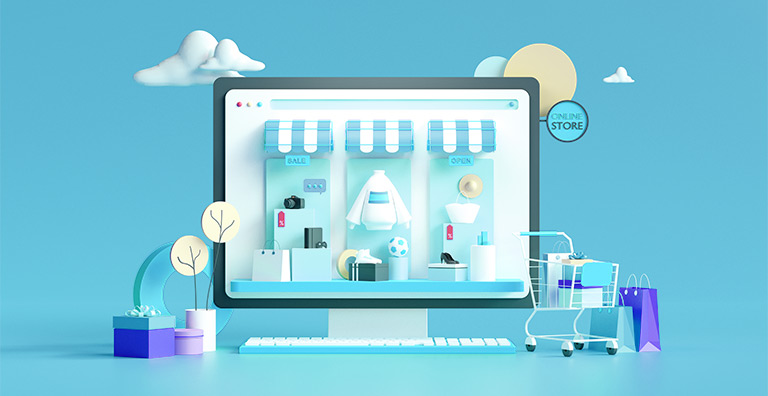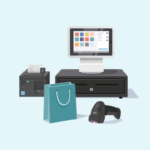There’s no doubt about it. The COVID-19 pandemic is impacting nearly every facet of our lives. And, experts are predicting that some of the behavior changes will be permanent. The way we shop – which was already evolving – is at the top of the list.
With buyers staying at home and stores temporarily closed, consumers who weren’t comfortable with online shopping took another look at the channel. As of March 2020, e-commerce orders jumped by 56 percent year-over-year, and online grocery orders increased by an incredible 233 percent. And, while customers will go back to shopping at brick-and-mortar stores, having an online option is more important than ever for retailers.
Between 2015 and 2019, e-commerce’s share of retail sales nearly doubled, growing from 7.4 percent to 14.1 percent. The growth is projected to increase, with 22 percent of retail sales expected to take place online by 2022 – and that estimate came before the events of 2020 pushed more consumers to try out online shopping. As a retailer, if you’re on the fence about whether your store needs an e-commerce option or if you’re contemplating whether you should invest in enhancing your current online capabilities, consider the following five ways e-commerce can transform your business.
1. Growth
For most retailers, the main reason to add an e-commerce option is to drive growth. Forty-three percent of small businesses that add online sales to their brick-and-mortar store see sizable revenue growth. Another 38 percent report a moderate revenue increase due to online sales.
Typically, adding e-commerce is a highly cost-effective channel that provides a strong return on investment for retailers. One of the best – and easiest – ways to optimize the return on your online shopping investment is by leveraging integrated e-commerce capabilities within your point-of-sale platform, which can include the launch and maintenance of an online store as well as comprehensive inventory management and reporting tools that communicate seamlessly between your e-commerce website and your Brick & Mortar POS.
2. Accessibility
Online shopping keeps your store open 24/7, 365 days a year. Customers – both existing and new – are able to access your products and complete a purchase when it’s most convenient for them. For loyal customers, choosing in-person shopping in your store or via your online channel isn’t an either/or decision. Many purchase experiences now involve both digital browsing and in-person interactions.
Consumers cite the anytime access, ability to save time, and the overall convenience of e-commerce options as the main reasons they choose to shop online.
3. Engagement
In effect, online shopping should be viewed as an extension of your overall customer experience. By designing the online and in-store experiences to complement each other, you can create an effective omnichannel experience that enables customers to move seamlessly from online to in-person to mobile shopping experiences.
Today’s customers expect omnichannel engagement. Think of it as a customer-centric shopping experience with a focus on making browsing and buying easy. The potential pay-off is worth it. Customers who engage via multiple channels spend up to 35 percent more per transaction and have a 30 percent higher customer lifetime value.
Related: Customer Expectations: Why Retailers Need to Deliver an Omnichannel Experience
4. Integration
Being available to customers online, anytime can help to strengthen customer relationships. In addition, having access to integrated customer data provides invaluable insights into their buying preferences and shopping behaviors.
Make sure your point-of-sale system brings together all the detailed information in an easily accessible way. Ideally, you want the ability to run comprehensive reports that inform your business decisions and marketing strategies. Plus, you want your team to have each customer’s purchase history, size and style preferences, and loyalty program status at their fingertips so they can deliver holistic, personalized shopping experiences.
5. Future-proof
Offering an e-commerce option is also an essential forward-looking retail strategy. Younger generations expect to have online access, and increasingly it’s the first thing they look for when choosing a retailer. Currently, Millennials, born between 1981 and 1996, are the largest generational group taking advantage of online shopping. In fact, Millennials make 60 percent of their purchases online. But, nearly half of their older generational counterparts, Gen X and Baby Boomers are doing some shopping online as well.
Things get interesting when you look at the next generation of customers, Gen Z, born between 1997 and 2012. As the first generation to grow up with a smartphone in their hand, online shopping is their go-to option. Seventy-five percent of Gen Z say they do the majority of their shopping online because of the convenience. However, eight in ten say they look forward to shopping in a brick-and-mortar store whenever they have the time. As a result, retailers who can appeal to Gen Z shoppers online have an excellent chance of building strong omnichannel relationships. E-commerce is fast becoming an essential strategy for retailers. POSIM is built to help brick-and-mortar retail stores successfully deliver a complimentary online shopping option. To learn more about POSIM’s e-commerce, point-of-sale, and inventory management, contact us for a walk-through.











